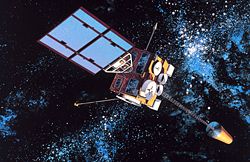GOES 8
 Artist's impression of a GOES-I series satellite in orbit | |
| Mission type | Weather satellite |
|---|---|
| Operator | NOAA / NASA |
| COSPAR ID | 1994-022A |
| SATCAT no. | 23051 |
| Mission duration | 3-5 years (planned) 10 years (achieved) |
| Spacecraft properties | |
Space Systems/Loral | |
| Launch mass | 2,105 kilograms (4,641 lb) |
| Start of mission | |
| Launch date | 13 April 1994, 06:04 UTC |
| Rocket | LC-36B |
| Contractor | Martin Marietta |
| End of mission | |
| Disposal | Decommissioned |
| Deactivated | 5 May 2004 |
| Orbital parameters | |
| Reference system | Geocentric |
| Regime | Geostationary |
| Longitude | 75° West |
| Slot | GOES-EAST (1995-2003) |
| Eccentricity | 0.0005384 |
| Perigee altitude | 36,151 kilometres (22,463 mi) |
| Apogee altitude | 36,197 kilometres (22,492 mi) |
| Inclination | 10.89° |
| Period | 1,456.0 minutes |
GOES-8, known as GOES-I before becoming operational, was an American
Launch
GOES-I was launched aboard a
GOES-8 was eventually raised to the correct orbit, and positioned at a longitude of 75° West.[4][7] Following on-orbit testing, it was activated as the GOES-EAST satellite, allowing GOES-7, which had previously been covering both positions, to assume GOES-WEST operations.
Operations

GOES-8 suffered from a design fault with the motor windings in its imager and sounder, with one of two sets failing within a few years of it becoming operational. If the other set had failed, it would have made the system inoperable. This fault also occurred on the GOES-9 satellite, which was launched in 1995. It was corrected before GOES-10 was launched.[8] In 1997, one of its momentum wheels failed, however unlike with GOES-9, the other wheel was not affected, and the satellite was able to continue operations.[4] GOES-8 was also featured in the 1996 film Twister.
GOES-8 was retired from GOES-EAST operations in 2003, when it was replaced by GOES-12.[9] Following this it remained in storage for a year as a backup, before being boosted to a graveyard orbit between 4 and 5 May 2004.[4]
See also
References
- ^ "GOES-NEWS". NASA. 2009-05-09. Archived from the original on 2004-06-05. Retrieved 2009-07-13.
- ^ "GOES-8 Spacecraft Status Summary". NOAA. Archived from the original on 2006-08-18. Retrieved 2009-07-13.
- ^ a b Krebs, Gunter. "GOES-8, 9, 10, 11, 12". Gunter's Space Page. Retrieved 2009-07-13.
- ^ a b c d "GOES-I Status". NOAA. Archived from the original on 2004-07-04. Retrieved 2009-07-11.
- ^ a b McDowell, Jonathan. "Launch Log". Jonathan's Space Page. Retrieved 2009-07-13.
- ^ ISBN 0-387-21519-0.
- ^ Wade, Mark. "GOES-Next". Encyclopedia Astronautica. Archived from the original on February 21, 2002. Retrieved 2009-07-11.
- ^ "GOES Motor Windings". NASA. 2001-04-27. Archived from the original on 2004-07-13. Retrieved 2009-07-11.
- ^ "GOES-8/12 Transition Plan" (PDF). NASA. 2002-10-28. Archived from the original (PDF) on 2004-10-30. Retrieved 2009-07-09.

